Keywords
cardiovascular disease, counselling, physical activity, prevention, recommendations
Abbreviation list
CAD: coronary artery disease
CRF: cardiorespiratory fitness
CVD: cardiovascular disease
PA: physical activity
WHO: World Health Organization
Take-home messages
- Engaging in physical activity is essential for everybody and has a substantial impact on cardiovascular health, contributing to a 27% reduction in relative risk of cardiovascular mortality.
- Most individuals with cardiovascular disease can safely engage in some form of physical activity, but careful assessment and guidance are needed in high-risk patients.
- PA is an effective treatment for patients with risk factors for cardiovascular disease - alongside any necessary medication and may even lead to diminished need for medication.
- Consistent counselling is crucial to determine each patient’s preferences while considering their personal obstacles.
Central Illustration. Physical activity and recreational sports counselling for patients and individuals.

Created with BioRender.com
CVD: cardiovascular disease; ECG: electrocardiography; PA: physical activity
Introduction
In an obesogenic society amidst a pandemic of physical inactivity, stimulation of exercise and physical activity (PA) is more relevant than ever [1]. Regular PA yields positive effects on risk factors for cardiovascular disease (CVD) and on all-cause mortality [2,3]. The aim of this review is to provide an overview of the role of PA in cardiovascular and general health, as well as for CVD prevention including current PA recommendations, PA in the general population and PA for patients with CVD and/or risk factors for CVD. Advice on counselling is presented.
Physical activity recommendations
A 2016 global assessment of physical inactivity revealed that 27.5% of adults and 81% of adolescents fail to meet the 2010 World Health Organization (WHO) recommendations [4]. According to Eurostat, this number was 67% among European adults. A study reported that only 5.8% of the European adults live a healthy lifestyle [5].
The World Health Organization (WHO) PA recommendations include advice for all adults to engage in regular PA to obtain the health benefits (Figure 1) associated with PA. PA is defined as any bodily movement by the skeletal muscles that requires energy expenditure [4]. Adults should engage in at least 150-300 minutes of moderate intensity aerobic PA per week, or at least 75-150 minutes per week of vigorous intensity aerobic PA [4]. For additional benefits, muscle strengthening activities, involving all major muscle groups, twice a week at moderate intensity is recommended. For adults >65 years of age, additional participation in varied multicomponent PA 3 or more times a week is advised, focussing on functional balance and strength training at moderate or greater intensity to enhance functional capacity and to prevent falls. The greatest cardiovascular benefits resulting from PA arise from improvements in cardiorespiratory fitness (CRF), expressed as maximum oxygen consumption (VO2max), which is known as a stronger predictor of prognosis than PA levels alone [6].
Figure 1. World Health Organization 2020 Guidelines on Physical Activity in adults.
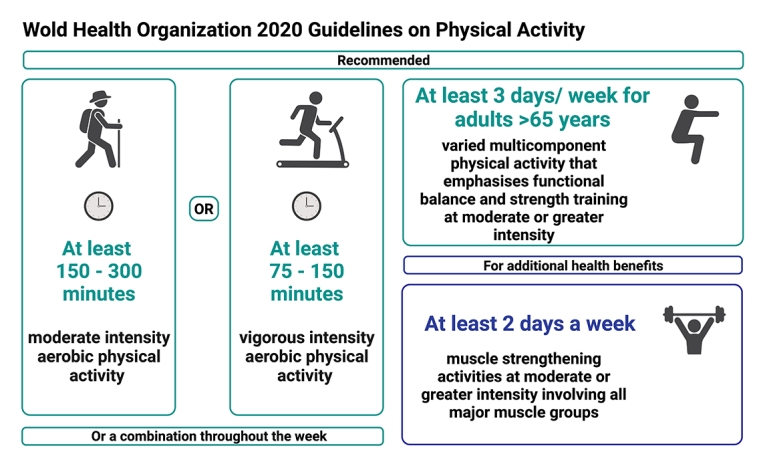
Created with BioRender.com
Components of different sports disciplines
Exercise and PA can be performed in countless ways [7]. Most exercises comprise a combination of dynamic and static circulatory demands. Dynamic exercise involves muscle contraction with change in length with joint movement and is especially associated with a rise in heart rate. Static exercise involves holding a position with unchanged muscle length and without joint movement and is especially associated with a rise in blood pressure. The mode of exercise training can be categorised into metabolic categories: aerobic and anaerobic. Aerobic exercise uses the metabolism of stored energy through aerobic glycolysis, meaning that the body needs to deliver oxygen to the muscles, which, in turn allows the muscles to perform the activity [7]. In contrast, anaerobic exercise uses the metabolism of stored energy to be processed largely by anaerobic glycolysis, it requires short bursts of exercise and is not dependent on oxygen delivery alone [7]. Exercise can be performed at different levels of intensity. The intensity of exercise can be categorised as low, medium and high intensity and depends on the individual’s maximum aerobic capacity (VO2max). Sport disciplines include skills, power, a mix of both power and skill or endurance capacities. A precise classification of sports remains a challenge because of the muscular work, mode and volume and intensity of exercise (Figure 2) [7]. Sports can be performed either at a competitive or recreational level. Competitive athletes are involved in regular (intense) training in organised individual or team sports, with an emphasis on competition and performance. Recreational athletes engage in sports for pleasure and leisure, with less emphasis on intense training and winning [7].
Figure 2. Components and levels of intensity in different sports disciplines.

Created with BioRender.com
Physical activity in the general population
In the general population, consistent PA and a healthy lifestyle are known to be protective both for prevention and control of multiple diseases, for all ages and both sexes. Engaging in any type of PA results in significant health benefits compared to a sedentary lifestyle [8-10]. Physical inactivity was seen to be responsible for the loss of 13.4 million disability-adjusted life years (DALYs) worldwide, these DALYs were estimated for coronary heart disease, stroke, type 2 diabetes, breast cancer, and colon cancer [11].
Regular PA contributes not only a positive effect on cardiovascular health, it also reduces the relative risks of breast, colorectal and prostate cancer-related mortality [8], maintains mental health, postpones the onset of dementia [9], prevents depression, and offers benefits for general well-being and weight management. Moreover, PA also results in positive effects on the musculoskeletal system, including increased bone density and fewer fractures. PA can also enhance social interactions and improve sleep and energy levels (Figure 3). Figure 4 presents the observed male/female differences in health benefits attributed to PA. More research is warranted to understand the mechanisms underlying the observed male/female differences [12].
Figure 3. Overview of the effects of physical activity on different diseases and outcomes.
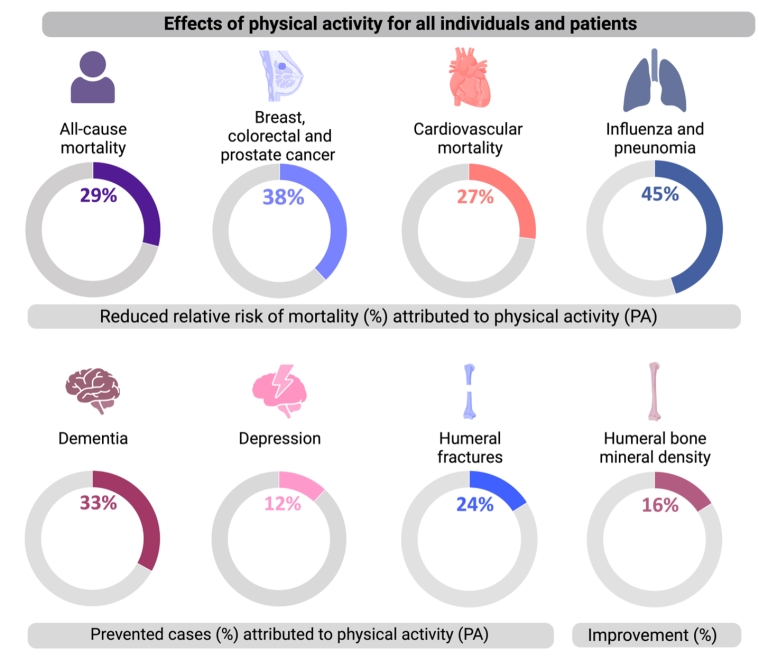
Created with BioRender.com
PA: physical activity
Figure 4. Overview of the differences in health benefits of physical activity in men and women.
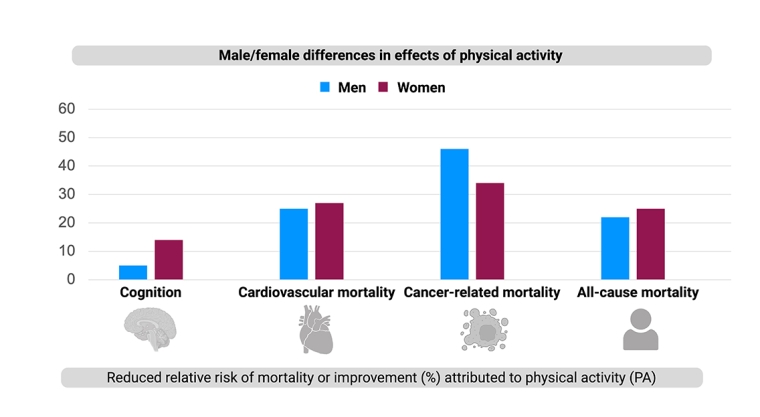
Created with BioRender.com
PA: physical activity
Finally, a physically active population is associated with economic advantages. Birmingham University in the United Kingdom has shown that PA not only has a positive impact on life expectancy, but also on workplace performance. Hypothetically, if all individuals in the world spent an extra 15 minutes per day walking, this would contribute approximately $100 billion annually to the global economy [13]. These benefits are linked to decreased healthcare costs, decreased illness and therefore less absenteeism at work, and increased (work) productivity.
Prevention in individuals with cardiovascular risk factors and/or patients with cardiovascular disease
An increase in the occurrence of comorbidities and risk factors combined with a decrease in the amount of (weekly) PA could potentially lead to various types of CVD, such as ischaemic and (haemorrhagic) stroke, coronary artery disease (CAD), heart failure and sudden cardiac death. PA and increasing one’s daily step count to 6,500 steps/day are associated with a reduced relative risk of CVD-related mortality of 49% [2], as well as a reduced incidence of CVD itself [3]. Figure 5 depicts the mechanisms behind the effects of PA on some of the traditional cardiovascular risk factors.
Figure 5. Effects of physical activity on some of the traditional cardiovascular risk factors.
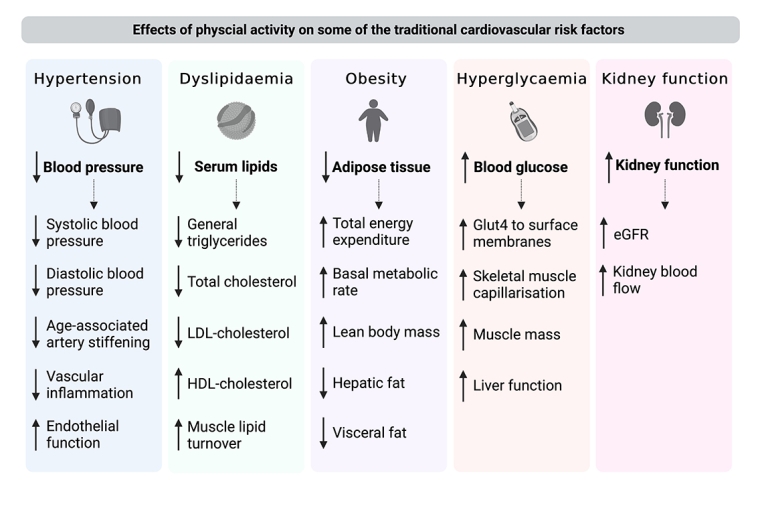
Created with BioRender.com
eGFR: estimated glomerular filtration rate; HDL: high-density lipoprotein; LDL: low-density lipoprotein.
Hypertension
PA can lower systolic and diastolic blood pressure with a mean of 7 mmHg and 5 mmHg, respectively [14]. PA decreases age-associated stiffening of large elastic arteries and reduces inflammation, which collectively contribute to a decrease in blood pressure. The blood pressure-lowering effects of PA seem comparable to those of commonly used antihypertensive medications. Increasing intensity and duration of PA can reduce the need for medication [15].
Dyslipidaemia
PA provides benefits regarding the blood lipid profiles. PA increases the metabolization of fat instead of glycogen with the activation of multiple enzymes that are required for lipid metabolism in the skeletal muscles [16]. PA therefore results in an increase in high-density lipoprotein cholesterol levels by 5%-10%, and a decrease in general triglycerides by 50%, low-density lipoprotein-cholesterol by 5% and, therefore, total cholesterol.
Obesity
PA reduces obesity and weight by increasing the daily energy expenditure, decreasing fat mass, maintaining a basal metabolic rate and lean body mass. PA increases psychosocial well-being, making it easier to adhere to PA routines. Aerobic exercise training in adults who are overweight or obese demonstrates a significant reduction in visceral and hepatic fat.
Insulin resistance and hyperglycaemia
Individuals engaging in PA can effectively reduce their blood glucose levels. There are several mechanisms contributing to this, including the movement of GLUT4 to the surface membranes and an increase of skeletal muscle capillarisation, both induced by exercise and resulting in skeletal muscle glucose uptake and transport [17]. Insulin resistant individuals as well as prediabetes patients can increase their glycaemic control and insulin sensitivity by undertaking PA.
Coronary artery disease
Almost all individuals at low risk for exercise-related adverse events who are diagnosed with chronic CAD are eligible to engage in some form of sport, whether competitive or recreational. Some of the high-risk phenotypes for exercise-induced adverse events for patients with chronic CAD include: critical coronary stenosis >70% in a major epicardial artery, a left ventricular ejection fraction of <50% and myocardial ischaemia on exercise testing [18]. For patients with CAD who are at high risk of exercise-induced adverse cardiac events, such as acute coronary syndromes or (supra) ventricular tachycardia, competitive sports are contraindicated.
Heart failure
Exercise programs for patients with heart failure (HF) can improve exercise tolerance and quality of life and have a modest impact on all-cause mortality, HF-specific mortality, all-cause hospitalisation, and HF-specific hospitalisation [19]. Exercise training, without any restrictions, is recommended for stable HF patients who are on optimal medical therapy, patients with low NT-pro-BNP and low New York Heart Association scores. For high-risk HF patients, individually tailored sports advice is warranted.
Valvular heart disease
The combination of a large stroke volume, vigorous contractions, and an increased chronotropic state (heart rate) induced by exercise could potentially lead to an increase in valve dysfunction and to higher afterload due to blood pressure increase. Nonetheless, asymptomatic individuals with mild to moderate valvular heart disease are encouraged to engage in all types of PA.
It is important to assess both the risk of exercise-induced cardiac events based on symptoms and the severity of valve dysfunction before initiating exercise because, PA could potentially lead to larger left ventricular dimensions and therefore to an earlier need for surgery. After careful assessment and consultation, asymptomatic patients with severe aortic valve regurgitation or moderate/severe aortic stenosis may be considered for participation in competitive sports.
Aortic disease
PA is advised in all patients with an aortic pathology, even when the aorta is dilated. However, due to the increase in blood pressure and wall stress caused by intense exercise and sports, some activities can potentially lead to further aortic enlargement leading to an increased risk of acute aortic dissection. In individuals at low risk, all types of sports are allowed and safe. However, as the aneurysm-related hazard for acute aortic events increases (larger diameter, hereditary pathology, rapid growth, or hypertension) more sports (especially the more intensive ones) become contraindicated [20].
Myocardial disease
PA during active myocarditis and pericarditis is contraindicated. Individuals with cardiomyopathy or a history of resolved myocarditis or pericarditis who desire to engage in regular sports activities should undergo a thorough evaluation. This evaluation should include not only an echocardiogram and MRI, but also an exercise test to assess the potential risk of exercise-induced arrhythmias. For individuals who are genotype positive but phenotype negative or have a mild cardiomyopathy phenotype, and who show no symptoms or risk factors, participation in competitive sports can be considered, depending on potential gene-specific interaction with sports (e.g. PKP2).
Arrhythmogenic conditions
The management of sports participation in patients with arrhythmogenic conditions is based on three principles [7]:
(1) prevention of life-threatening arrhythmias during exercise,
(2) management of symptoms to enable sports participation, and
(3) evaluating the progression of the arrhythmogenic condition due to sports involvement. In every patient, these three questions need to be addressed. PA is effective in the prevention of atrial fibrillation (AF). In individuals without structural heart disease and in individuals with well-tolerated AF, participation in sports can be considered.
Congenital heart disease
Due to the considerable variation in haemodynamic conditions and prognosis in patients with congenital heart disease (CHD), a personalised exercise plan should be established, including regular re-evaluations. However, participation in some form of PA is recommended for all patients with CHD [21]. Engaging in moderate-intensity aerobic exercise for a minimum of 30 minutes, 4 to 5 times a week, is considered both safe and effective in almost all patients with congenital heart disease (CHD) [22].
Risk stratification and safety
General population
Encouraging individuals in the general population to perform PA and adopt a healthy lifestyle is important to prevent (cardiovascular) risk factors and associated disease and mortality. An evaluation of an individual’s clinical history and a physical examination by a general practitioner can help to identify the type of sports a patient can or cannot engage in. For example, if you have an individual with severe rheumatoid arthritis in the knees, it might be more appropriate to choose swimming, walking, or biking. To counsel individuals effectively, it is important to draw a distinction between those who are already active and those who are sedentary. A sedentary individual might need more help and a slower PA built-up scheme compared to an individual who is already active. Lifestyle coaches, dietitians and psychologists can provide extra guidance for patients who struggle to adopt a healthier lifestyle.
Individuals with cardiovascular risk factors
Following current recommendations [7], calculating the accumulated risk through cardiovascular risk scores (e.g., SCORE2), evaluating the patient’s clinical history and performing a physical examination for cardiovascular events in individuals with cardiovascular risk factors determines the safety of PA and permitted exercise intensity. Individuals with a low determined risk do not require any exercise restrictions.
Patients with cardiovascular disease
Since all exercise yields a positive effect on cardiovascular health, some forms of exercise should be recommended to all patients. Risk assessment should at least include a thorough physical examination including electrocardiography while also taking a patient’s complete clinical history into account. Depending on the screening results, low-risk patients with CVD (low-risk CAD, stable HF, asymptomatic/mild valvular heart disease, low risk aortic disease, well-tolerated AF, simple CHD) require no exercise restrictions [7]. Additional risk assessment is required for high-risk patients prior to PA and should at least include echocardiography, an exercise stress test and, when needed, advanced imaging. Screening before participation in recreational and competitive sports is mostly focused on detecting disorders potentially associated with sudden cardiac death. For high-risk patients with CVD, an individualised exercise plan is warranted. Following the 2020 ESC Guidelines on sports cardiology and exercise in patients with CVD, high-risk patients should receive counselling more frequently than low-risk patients [7].
Exercise may complement the need for medication and contribute to a reduction in polypharmacy. In addition to the simplification of the management and the reduction in healthcare costs, this could be a motivation to increase PA levels by engaging in relatively simple PA such as walking or cycling, people can easily meet the recommended activity levels throughout the week.
How can I encourage my patient to engage in physical activity
Although the evidence for favourable effects has been well proven, patients may encounter diverse obstacles when attempting to engage in PA. These obstacles can vary, depending on health condition, lifestyle, personal circumstances, and motivation. Common obstacles to consider when trying to increase a patients’ engagement in PA include financial limitations, lack of time, challenges in transport, insufficient social support, concerns about potential harm, restricted access to exercise facilities, physical limitations and cultural or social norms. It is therefore crucial when preparing a patient's treatment plan, to consider the disease and the patient's condition, along with individual characteristics, the patient’s daily life, wishes, and potential individual obstacles.
Six domains have been previously identified for lifestyle counselling [23]: exercise, diet, substance use, sleep, social interactions, and relaxation. When counselling individuals/patients on their lifestyle, it is important to ask the individual which domains they consider most important. Start with small improvements in the domain the patient considers can be of help, as this is often the domain with the highest level of intrinsic motivation. Hence, a patient will potentially be able to maintain healthy habits for a longer time and be more motivated to make improvements in other domains.
While counselling patients or individuals on PA, it is important to consider that each patient may have a unique and individual perspective regarding PA. For instance, some patients may have participated in competitive or professional sports before being diagnosed with CVD. In such cases, it is essential to provide information on the potential risks linked to excessive and high-intensity sports. Some patients need to adjust their performance and change to lower intensity activities. While in other cases, patients may require more encouragement to initiate or expand PA. Figure 6 illustrates a tool with questions in four domains (rationale, preference, obstacles, and guidance) that could help physicians to start the conversation about PA. It could help to assess the patient's willingness and viewpoint regarding PA. This tool can be used to determine the level of support or counselling required.
Figure 6. Tool for counselling individuals on physical activity – where to start?
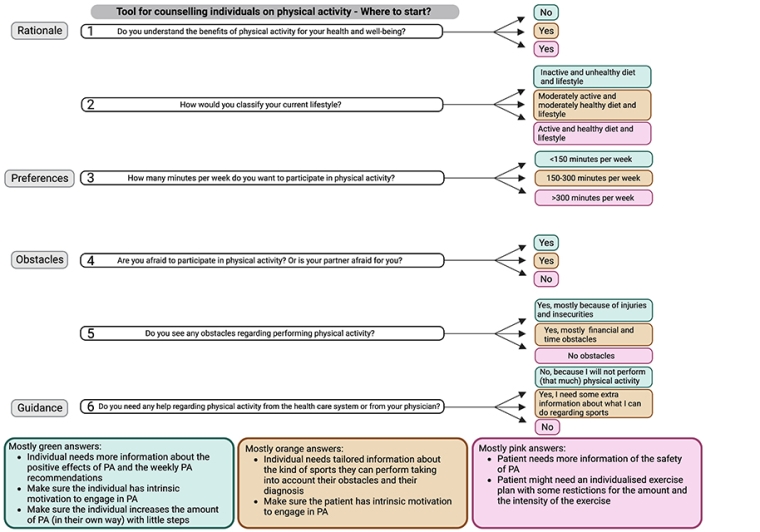
Created with BioRender.com
PA: physical activity
To monitor the safety of sports participation for patients with CVD the use of personal wearable devices for example a sport watch can be considered [22].
Rehabilitation and prehabilitation
After experiencing an acute coronary syndrome, international guidelines advise cardiac rehabilitation (CR). CR focuses on physical and mental recovery and the prevention of recurrent cardiac events by targeting cardiovascular risk factors and healthy lifestyle adoption, including achieving optimal PA levels. CR improves PA, although the improvements are small and long-term maintenance is still suboptimal [24].
If CVD progresses, despite optimal treatment strategies, cardiac interventions (surgical or endovascular procedures) can be indicated. CRF can be increased preoperatively, improving postoperative outcomes [25].
Prehabilitation (PA proposed prior to surgery to enhance CRF) potentially improves post-surgery complications and outcomes. However, limited evidence is available regarding exercise prehabilitation before cardiac surgery. Furthermore, there is no specific data available regarding this option in high-risk patients undergoing CABG or valvular replacement. The discussion of exercise prehabilitation for cardiac patients should involve a multidisciplinary team to ensure safety, and research in this field is clearly warranted.
Conclusion
As of 2024, a trend towards a sedentary lifestyle coupled with increased rates of smoking and obesity underscores the need for a global initiative to enhance cardiovascular health. This initiative should focus on motivating and guiding the general population as well as CVD patients to participate in PA. PA is highly recommended in the context of the prevention of CVD. After an accurate risk stratification, almost all patients with CVD can engage in some form of PA. Healthcare professionals should discuss the potential obstacles faced by patients and implement a personalised exercise plan as an important treatment strategy. The goal is to achieve optimal cardiovascular fitness for everyone.





 Our mission: To reduce the burden of cardiovascular disease.
Our mission: To reduce the burden of cardiovascular disease.